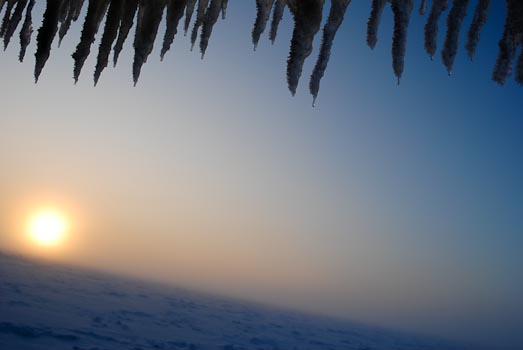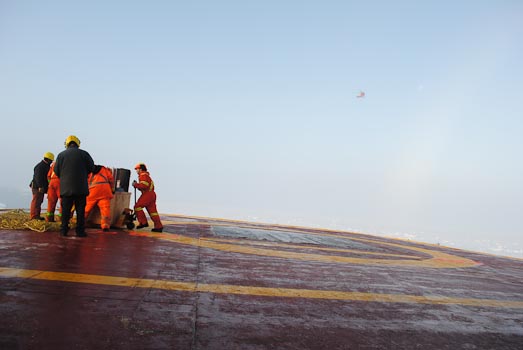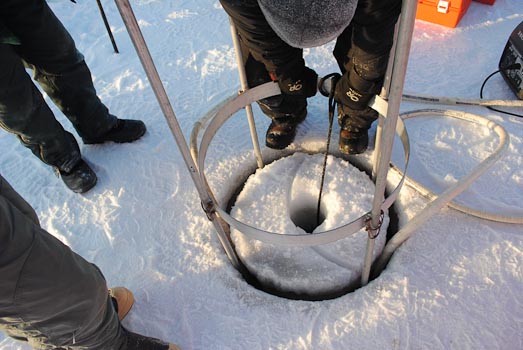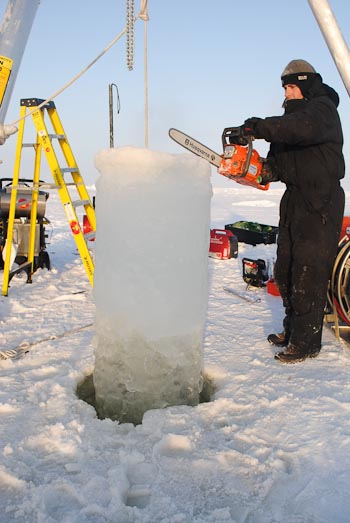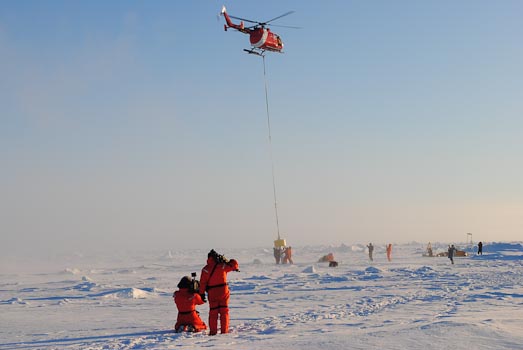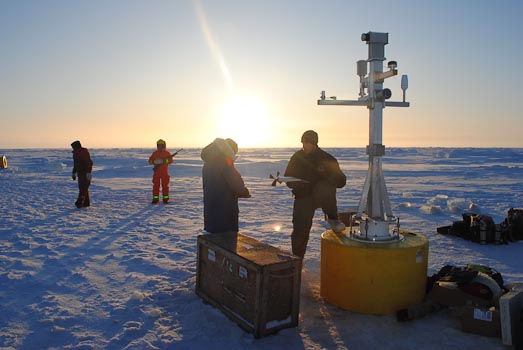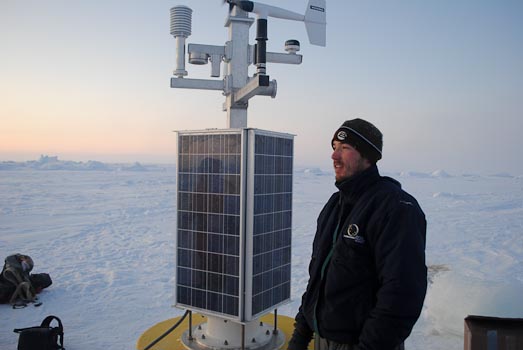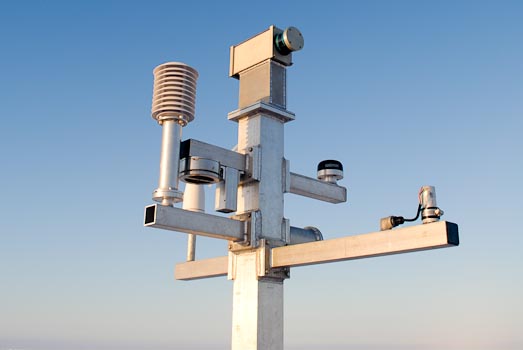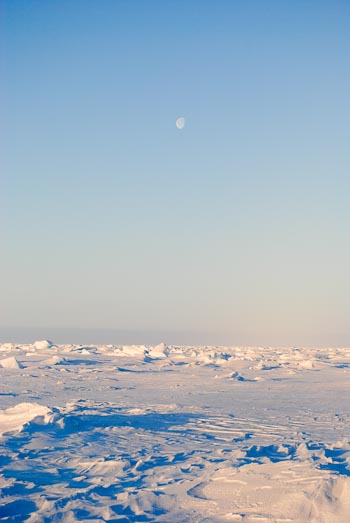Alex KainOctober 7, 2009Last night, the stars aligned and Neptune smiled on the Beaufort Sea. In the morning, a crystal blue sky draped over the horizon. The Arctic sun—glowing, yellow, and low—lingered behind a veil of clouds, providing ample light without the blinding radiance often found at high latitudes.
The conditions provided an ideal day for a buoy extravaganza. In total, 19 individuals flew from the CCGS Louis S. St-Laurent for a day of sea ice sampling and the installation of an Ice-Based Observatory, a group of buoys that will give scientists a longitudinal picture of ice, weather, and ocean dynamics. The various projects executed at the research site composed a frenzy of activity. It was a five-ring Arctic research circus, missing only a bike-riding polar bear and a fire-breathing narwhal. In one ring, the WHOI team installed an Ice-Tethered Profiler. Next to them, Mike Dempsey from Fisheries and Oceans Canada (DFO) installed an Ice Mass Balance Buoy. DFO's Kristina Brown sawed ice core samples into adorable ten-centimeter segments while Alice Orlich from the University of Alaska-Fairbanks amazed onlookers with her superb ice corer skill. Alongside Orlich, Kazu Tateyama from the Kitami Institute of Technology so gently and deftly measured snow and ice thickness. And then there was the Obuoy, the scientific lovechild of environmental chemist Dan Carlson and eighteen other collaborators. The Obuoy is a punny chap, named for the sake of wit, not acronym. Get it? "Buoy" sounds like "boy." Environmental chemists can't also be comedians. The Obuoy takes webcam footage of the Beaufort Sea and resembles an enormous bird feeder. More importantly, it monitors three compounds present in the Arctic atmosphere: carbon dioxide (CO2), ozone (O3), and bromine monoxide (BrO).
Bad boy of the Arctic carbon dioxide has received by far the most press of these compounds. CO2 is a greenhouse gas. The compound gets its baleful status by hovering in the atmosphere, trapping heat on earth, increasing global temperatures, decreasing sea ice cover, and allowing Al Gore to win a Nobel Prize. It also dissolves in water. It is carbon dioxide's solubility that allows for the delicious and tingly bubbles of seltzer water. But it's not all fun and bubbles for CO2. Carbon dioxide also gets absorbed into the world's oceans. When CO2 concentrations get too high, the water acidifies and dissolves the exoskeleton of any animal with an outer shell.
However, the ocean has a natural warrior team that battles this chemical intruder: carbonate buffers and algae. The buffers resist the change in acidity by limiting the extent to which hydrogen ions can alter pH. Algae photosynthesize the ocean's dissolved CO2 into oxygen. During the summer, when there's abundant sunlight, this happens more than in the winter, when the sun is out for shorter periods, or, in the case of the Arctic, not at all. Though this algae absorption process happens year round in the sunny regions of the world, in Polar Regions the process is a little more complicated. First off, the frigid water of the Arctic absorbs more CO2 than warmer water. Think of a bottle of that seltzer. It stores dissolved fizz better when it's cold. Second, the Arctic Ocean can't absorb CO2 when it's completely covered in ice. Ice cover means the ocean isn't in touch with the atmosphere. So, instead of sinking into the ocean and providing an all-you-can-eat-dissolved-gas buffet for algae and phytoplankton, it stays in the atmosphere and heats things up. Carbon dioxide has a natural enemy in the form of ozone, earth's most abundant oxidizer. Ozone is ambient in earth's surface atmosphere. It also exists in strong concentrations in the Ozone layer, which got a lot of press in the mid-90's but was then eclipsed by the popularity of whale conversation. Ozone and whales are no longer on speaking terms nor are they Facebook friends. Ozone protects earth from the harmful UV rays of the sun. Below its eponymous layer, ozone is also responsible for cleaning pollutants from the atmosphere. As an oxidizer, ozone steals electrons from harmful pollutants and renders them into less harmful chemicals. Think of ozone as an Arctic superhero. Every superhero has his or her weakness. Achilles has his heel. Superman has his Kryptonite. Ozone has its bromine monoxide. Every spring in the Arctic, bromine monoxide in sea ice causes O3 levels deplete to zero through a catalytic cycle. BrO combines with elemental oxygen to form ionic bromine and ozone. Ionic bromine then reacts with ozone to produce BrO and elemental oxygen. The cycle repeats until ozone levels completely deplete.
While ozone depletes, mercury enters the polar ecosystem from volcanic activity and human production. It also drifts into polar seas from contamination in the North Pacific. Everyone knows mercury. It's what causes that little pang of concern in the back of your mind every time you eat a piece of tuna. With reduced sea ice cover and no ozone to ward it off, the mercury enters ocean water and invades the earth's food chain, risking biological harm and creating 10 o'clock evening news specials with teasers like "Think that sashimi is delectable? Well, it will probably kill you. More in five minutes." Carlson's Obuoy will monitor CO2, O3, and BrO to improve the understanding of how sea ice cover affects these interrelated processes. The Beaufort Gyre Circus Spectacular comes with real results, not just sticky sno-cone hands and a $15 commemorative mug that you didn't want in the first place. All text and photos property of Alex Kain. Last updated: October 7, 2019 | |||||||||||||||||||||||||||||||||||||||||
Copyright ©2007 Woods Hole Oceanographic Institution, All Rights Reserved, Privacy Policy. | |||||||||||||||||||||||||||||||||||||||||


